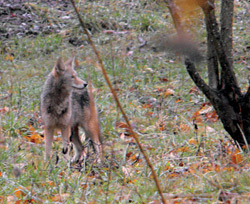
IRIS login | Reed College home Volume 96, No. 2: June 2017
100 Years of the Canyon
Ask anyone about Reed's campus and they are sure to mention the canyon. The 28-acre watershed--a critical part of the Crystal Springs Creek--is a beautiful sanctuary for observing wildlife, taking a walk, or simply gathering your thoughts. It's also, as one alumna put it, "very romantic."
Biology professor Keith Karoly agrees. "That's biology, too," he quipped during his presentation on science in the canyon, a lecture he gave June 8, as part of Centennial Reunions. The participation of the audience--alumni from the 1940s to the present--made it clear that the canyon is a central part of both Reed's and Reedies' identities.
Karoly began his thoughtful retrospective of the canyon's 100-year history--glimpsed through the lens of science--by noting its formation by the Missoula Floods approximately fifteen-thousand years ago. By the time the land was acquired by Reed, the canyon was little more than a degraded agricultural ditch; it's almost unrecognizable in archival photos of Reed's early years. The introduction into Oregon of non-native plant and animal species (including garlic mustard, poison ivy, and nutria) combined with human-inflicted damage (well, yes, that outdoor swimming pool) made for some obvious problems. The canyon became a dumping ground for all manner of materials, including, the legend goes, a police car.
One alumnus mentioned that during the 1960s "traditional thinkers" referred to the canyon as "the swamp." But another, from the class of '56, remembered eating lunch there everyday while happily watching crayfish, usually a sign of a healthy water system, work out their pecking order.
Restoration efforts began in earnest in the early 1990s with the cultivation of the canyon as a habitat for salmon. The swimming pool was demolished, and students constructed a salmon-rearing box. In 1999, the college hired Zac Perry, horticulturalist, botanist, and all-around canyon guru. Working with a large team of students and in concert with faculty and academic activities, he has spearheaded efforts to restore the canyon to a healthy, thriving habitat for plants and animals. Invasive species are systematically removed without the use of chemicals, and onsite plants are used for revegitation. The most recent restoration efforts are at the canyon's western edge where a large project financed by the city or Portland added a fish-friendly meander and culvert to the area where the stream passes under 28th Avenue.
These efforts have born fruit. Wild steelhead trout have been spotted in the canyon, not to mention blue herons, eagles, and coyotes.
In the course of restoration efforts, the college has been mindful of the canyon's role in the academic program. Only 14 theses were written about the canyon before 1990; since then, 28 have found their home in the thesis tower. Science classes that use the canyon as a backyard laboratory include Bio 101 (looking at the evolution of stickleback fish and the levels of coliform bacteria in canyon water), Bio 332 (investigating how the evolution of the Indian plum's supports resource specialization), and Bio 358 (determining the source of high levels of coliform bacteria in canyon water).
Student projects include investigations of thermogenesis in skunk cabbage and the construction of a series of ponds that aim to create an ideal habitat for the northern red-legged frog. Zac and his team work with the understanding that what they do affects research done in the canyon and that such research can be a guide to restoration. An alumnus remarked that the Reed College Christian Fellowship used to baptize people in the lake. "So that makes me wonder," he said dryly, "about that e coli."
In addition, some 1,500 students in grades K through 12 visit the canyon from neighborhood schools to do basic research and release fish into canyon waters.
An alumnus remembered being so excited by a blue heron flying within arms' reach that she ran to tell Dean of Students Jack Dudman about it. What are your memories of the canyon? How has the canyon changed since you were a student here? Share your memories in a comment below.
Tags: bio, canyon, centennial, coyote, Karoly, police car, reunions



LATEST COMMENTS
steve-jobs-1976 I knew Steve Jobs when he was on the second floor of Quincy. (Fall...
Utnapishtim - 2 weeks ago
Prof. Mason Drukman [political science 1964–70] This is gold, pure gold. God bless, Prof. Drukman.
puredog - 1 month ago
virginia-davis-1965 Such a good friend & compatriot in the day of Satyricon...
czarchasm - 4 months ago
John Peara Baba 1990 John died of a broken heart from losing his mom and then his...
kodachrome - 7 months ago
Carol Sawyer 1962 Who wrote this obit? I'm writing something about Carol Sawyer...
MsLaurie Pepper - 8 months ago
William W. Wissman MAT 1969 ...and THREE sisters. Sabra, the oldest, Mary, the middle, and...
riclf - 10 months ago